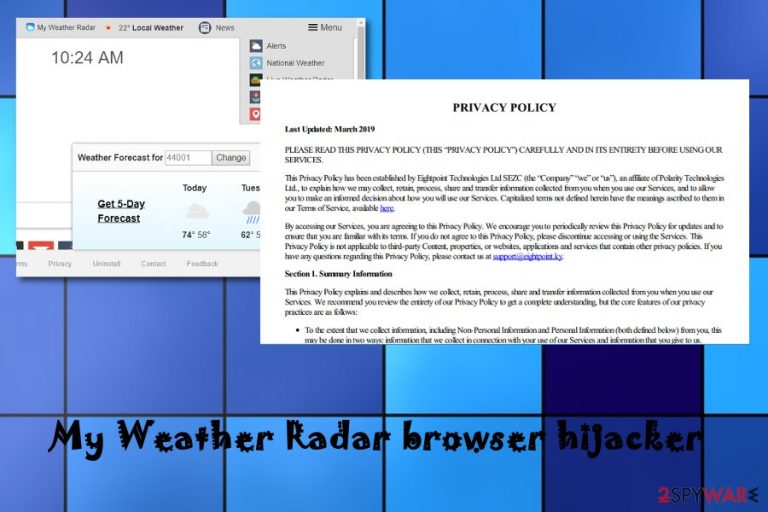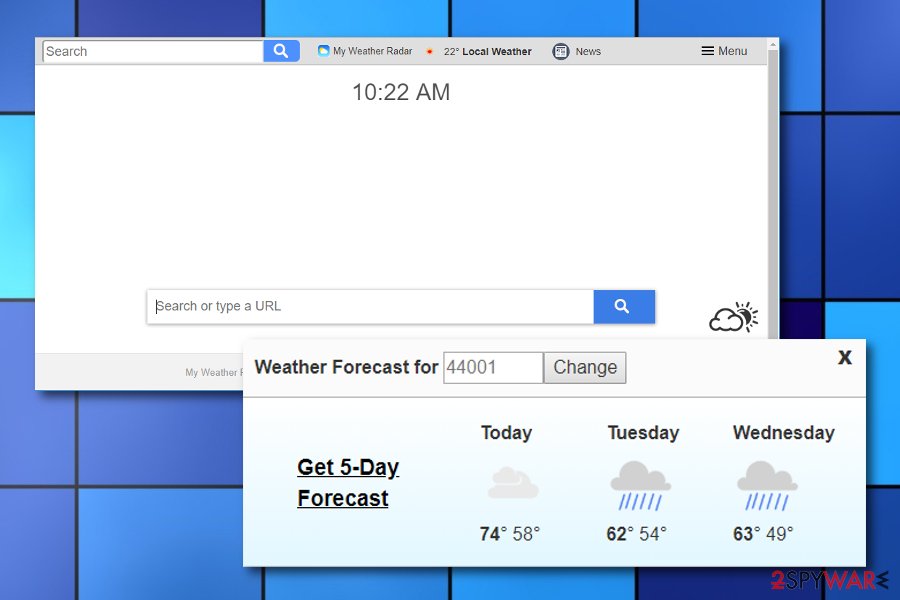My Weather Radar (Virus Removal Instructions) - Tutorial
My Weather Radar Removal Guide
What is My Weather Radar?
My Weather Radar – a browser hijacker which overtakes the default search engine and brings weather forecast extensions

My Weather Radar is called a “browser hijacker” because it plants rogue extensions into browsers to modify them. Researchers have discovered that this tricky application appears as the search.hmyweatherradar.co search engine mostly on Google Chrome, Mozilla, and Internet Explorer. My Weather Radar, developed by an affiliate from Polarity Technologies Ltd., aims to change default settings, appear on the homepage, and bring other suspicious shortcuts to the browser.
My Weather Radar appears as the new search engine and adds rogue shortcuts to the browser toolbar. Such objects are weather.com/maps/severealerts, nationalweatheragency.org, and weather.gov. All of these components together with the PUP itself provide weather-watching services which might appear very attractive to users.
| Name | My Weather Radar |
|---|---|
| Type | Browser hijacker |
| Appearance | This PUP mostly appears on Chrome, Firefox, and Explorer |
| Engine | search.hmyweatherradar.co |
| Relations | weather.com/maps/severealerts, nationalweatheragency.org, and weather.gov |
| Main activities | Modifying browser settings, tracking browsing, redirecting to affiliate sites, advertising |
| Distribution | Bundled freeware/shareware, unprotected networks |
| Removal tool | Use FortectIntego |
Even though the browser hijacker provides comfortable shortcuts to weather forecast, news sources, electronic mail, and other popular networks, it still has gained the name of My Weather Radar virus. Some relations to malware are made because the program injects itself unknowingly and completes different types of changes without asking for permission.
If you ever read the Privacy Policy of My Weather Radar, you will understand that this program might perform a big variety of unpleasant activities. However, they are still mentioned and provided for you, so they appear to be legitimate but still troubling. For example, the program developers claim that they use tracking cookies[1] for increasing browsing quality only:
When you visit our Services, we may send your computer or mobile device a cookie that uniquely identifies your browser. Cookies that we may use may only be read by the server that placed them there. Our use of cookies is primarily focused on improving the quality of our Services and your use of those Services.
However, how much beliefs you put into such claims is upon you. If you take a closer look at the Privacy Policy, you should see that My Weather Radar is capable of tracking your browsing activities for the collection of various information. According to the developers, some of this data might appear to be personal too. For example, email addresses.
Mostly, My Weather Radar will supposedly track pages that you have visited, your IP address, views of websites, saved bookmarks, installed extensions and plug-ins, geographic location, type of web browser being used, and so on. It is known that developers are likely to share this type of data with other parties for receiving income.

Besides all the hijacking and tracking activities that My Weather Radar is capable of, this browser hijacker seems to generate search results from a legitimate search engine – Yahoo.[2] This makes the app useless itself. Why not just use Yahoo instead and avoid all unwanted activities that might be brought?
However, there are a lot of people with fall for all of the tricks that are used by PUP developers. Sometimes, and attractive look is all that is needed to convince users to install My Weather Radar. Sadly, this might relate to unwanted advertising activities and redirecting that can be the result of secret malware invasion through third-party sources.
The best way to protect yourself from such activities is to remove My Weather Radar from your computer system and web browser applications. For this purpose, you will have to eliminate all suspicious extensions and plug-ins[3] that have been brought to your machine by the browser-hijacking program.
Our suggestion would be to use FortectIntego for an easier and more effective My Weather Radar removal. However, if you are likely to, you can go ahead and try performing the step-by-step guide which is placed at the end of this article. Choosing the right and more comfortable elimination method is your choice only.

Distribution sources of browser-hijacking apps
According to cybersecurity researchers from Virusai.lt,[4] browser hijackers are known for their abilities to secretly attack web browsers after installing through specific software packages. However, these PUPs can also appear throughout a big variety of third-party networks. For example, peer-to-peer sites, gambling pages, and similar. According to experts, if you want to protect yourself from such PUPs properly, you should:
- Choose Custom or Advanced configuration as your default downloading/installing mode. This option will allow you to track all incoming objects regularly and opt for their removal if you are likely to.
- Stay away from any unknown sources. The most potentially dangerous websites usually are gambling, online-gaming, and adult-themed pages which should be always avoided.
- Keep all of your products, tools, and software updated. Make sure that you regularly perform updates for all of your software and components that you have on your computer/laptop.
- Purchase a reliable antivirus/anti-malware program. Automatical protection is necessary for each device and machine because it usually spots everything that is left behind and even works outside active hours.
Some guidance on the My Weather Radar removal process
My Weather Radar virus might be extremely annoying to you if you did not opt for its downloading process and have been receiving pop-ups, redirects, and suspicious browser changes from this program lately. Good news is that this browser hijacker is not hard to get rid of and the process can be completed in two ways.
The easier and supposedly more effective way to remove My Weather Radar from your Windows or Mac operating systems is to launch a reputable anti-malware program that will take care of the entire activity. Additionally, these tools are not only for scanning purposes but they also can repair and optimize the machine.
However, if you are likely to, you can also succeed with My Weather Radar removal by using the step-by-step guidelines that we have provided at the end of this article. Following these instructions should allow you to clean all infected web browser applications and remove questionable objects that were injected by the PUP.
You may remove virus damage with a help of FortectIntego. SpyHunter 5Combo Cleaner and Malwarebytes are recommended to detect potentially unwanted programs and viruses with all their files and registry entries that are related to them.
Getting rid of My Weather Radar. Follow these steps
Uninstall from Windows
Eliminate suspicious entries and processes from your Windows operating system. This can be done with the help of these guidelines:
Instructions for Windows 10/8 machines:
- Enter Control Panel into Windows search box and hit Enter or click on the search result.
- Under Programs, select Uninstall a program.

- From the list, find the entry of the suspicious program.
- Right-click on the application and select Uninstall.
- If User Account Control shows up, click Yes.
- Wait till uninstallation process is complete and click OK.

If you are Windows 7/XP user, proceed with the following instructions:
- Click on Windows Start > Control Panel located on the right pane (if you are Windows XP user, click on Add/Remove Programs).
- In Control Panel, select Programs > Uninstall a program.

- Pick the unwanted application by clicking on it once.
- At the top, click Uninstall/Change.
- In the confirmation prompt, pick Yes.
- Click OK once the removal process is finished.
Delete from macOS
Remove items from Applications folder:
- From the menu bar, select Go > Applications.
- In the Applications folder, look for all related entries.
- Click on the app and drag it to Trash (or right-click and pick Move to Trash)

To fully remove an unwanted app, you need to access Application Support, LaunchAgents, and LaunchDaemons folders and delete relevant files:
- Select Go > Go to Folder.
- Enter /Library/Application Support and click Go or press Enter.
- In the Application Support folder, look for any dubious entries and then delete them.
- Now enter /Library/LaunchAgents and /Library/LaunchDaemons folders the same way and terminate all the related .plist files.

Remove from Microsoft Edge
Delete unwanted extensions from MS Edge:
- Select Menu (three horizontal dots at the top-right of the browser window) and pick Extensions.
- From the list, pick the extension and click on the Gear icon.
- Click on Uninstall at the bottom.

Clear cookies and other browser data:
- Click on the Menu (three horizontal dots at the top-right of the browser window) and select Privacy & security.
- Under Clear browsing data, pick Choose what to clear.
- Select everything (apart from passwords, although you might want to include Media licenses as well, if applicable) and click on Clear.

Restore new tab and homepage settings:
- Click the menu icon and choose Settings.
- Then find On startup section.
- Click Disable if you found any suspicious domain.
Reset MS Edge if the above steps did not work:
- Press on Ctrl + Shift + Esc to open Task Manager.
- Click on More details arrow at the bottom of the window.
- Select Details tab.
- Now scroll down and locate every entry with Microsoft Edge name in it. Right-click on each of them and select End Task to stop MS Edge from running.

If this solution failed to help you, you need to use an advanced Edge reset method. Note that you need to backup your data before proceeding.
- Find the following folder on your computer: C:\\Users\\%username%\\AppData\\Local\\Packages\\Microsoft.MicrosoftEdge_8wekyb3d8bbwe.
- Press Ctrl + A on your keyboard to select all folders.
- Right-click on them and pick Delete

- Now right-click on the Start button and pick Windows PowerShell (Admin).
- When the new window opens, copy and paste the following command, and then press Enter:
Get-AppXPackage -AllUsers -Name Microsoft.MicrosoftEdge | Foreach {Add-AppxPackage -DisableDevelopmentMode -Register “$($_.InstallLocation)\\AppXManifest.xml” -Verbose

Instructions for Chromium-based Edge
Delete extensions from MS Edge (Chromium):
- Open Edge and click select Settings > Extensions.
- Delete unwanted extensions by clicking Remove.

Clear cache and site data:
- Click on Menu and go to Settings.
- Select Privacy, search and services.
- Under Clear browsing data, pick Choose what to clear.
- Under Time range, pick All time.
- Select Clear now.

Reset Chromium-based MS Edge:
- Click on Menu and select Settings.
- On the left side, pick Reset settings.
- Select Restore settings to their default values.
- Confirm with Reset.

Remove from Mozilla Firefox (FF)
If you have been looking for ways to clean and refresh your Mozilla Firefox web browser application, you should look at our provided instructions:
Remove dangerous extensions:
- Open Mozilla Firefox browser and click on the Menu (three horizontal lines at the top-right of the window).
- Select Add-ons.
- In here, select unwanted plugin and click Remove.

Reset the homepage:
- Click three horizontal lines at the top right corner to open the menu.
- Choose Options.
- Under Home options, enter your preferred site that will open every time you newly open the Mozilla Firefox.
Clear cookies and site data:
- Click Menu and pick Settings.
- Go to Privacy & Security section.
- Scroll down to locate Cookies and Site Data.
- Click on Clear Data…
- Select Cookies and Site Data, as well as Cached Web Content and press Clear.

Reset Mozilla Firefox
If clearing the browser as explained above did not help, reset Mozilla Firefox:
- Open Mozilla Firefox browser and click the Menu.
- Go to Help and then choose Troubleshooting Information.

- Under Give Firefox a tune up section, click on Refresh Firefox…
- Once the pop-up shows up, confirm the action by pressing on Refresh Firefox.

Remove from Google Chrome
Reversing all unexpected changes and deleting unwanted extensions from Google Chrome easily is truly possible. What you need to do is follow these steps carefully:
Delete malicious extensions from Google Chrome:
- Open Google Chrome, click on the Menu (three vertical dots at the top-right corner) and select More tools > Extensions.
- In the newly opened window, you will see all the installed extensions. Uninstall all the suspicious plugins that might be related to the unwanted program by clicking Remove.

Clear cache and web data from Chrome:
- Click on Menu and pick Settings.
- Under Privacy and security, select Clear browsing data.
- Select Browsing history, Cookies and other site data, as well as Cached images and files.
- Click Clear data.

Change your homepage:
- Click menu and choose Settings.
- Look for a suspicious site in the On startup section.
- Click on Open a specific or set of pages and click on three dots to find the Remove option.
Reset Google Chrome:
If the previous methods did not help you, reset Google Chrome to eliminate all the unwanted components:
- Click on Menu and select Settings.
- In the Settings, scroll down and click Advanced.
- Scroll down and locate Reset and clean up section.
- Now click Restore settings to their original defaults.
- Confirm with Reset settings.

Delete from Safari
Remove unwanted extensions from Safari:
- Click Safari > Preferences…
- In the new window, pick Extensions.
- Select the unwanted extension and select Uninstall.

Clear cookies and other website data from Safari:
- Click Safari > Clear History…
- From the drop-down menu under Clear, pick all history.
- Confirm with Clear History.

Reset Safari if the above-mentioned steps did not help you:
- Click Safari > Preferences…
- Go to Advanced tab.
- Tick the Show Develop menu in menu bar.
- From the menu bar, click Develop, and then select Empty Caches.

After uninstalling this potentially unwanted program (PUP) and fixing each of your web browsers, we recommend you to scan your PC system with a reputable anti-spyware. This will help you to get rid of My Weather Radar registry traces and will also identify related parasites or possible malware infections on your computer. For that you can use our top-rated malware remover: FortectIntego, SpyHunter 5Combo Cleaner or Malwarebytes.
How to prevent from getting browser hijacker
Choose a proper web browser and improve your safety with a VPN tool
Online spying has got momentum in recent years and people are getting more and more interested in how to protect their privacy online. One of the basic means to add a layer of security – choose the most private and secure web browser. Although web browsers can't grant full privacy protection and security, some of them are much better at sandboxing, HTTPS upgrading, active content blocking, tracking blocking, phishing protection, and similar privacy-oriented features. However, if you want true anonymity, we suggest you employ a powerful Private Internet Access VPN – it can encrypt all the traffic that comes and goes out of your computer, preventing tracking completely.
Lost your files? Use data recovery software
While some files located on any computer are replaceable or useless, others can be extremely valuable. Family photos, work documents, school projects – these are types of files that we don't want to lose. Unfortunately, there are many ways how unexpected data loss can occur: power cuts, Blue Screen of Death errors, hardware failures, crypto-malware attack, or even accidental deletion.
To ensure that all the files remain intact, you should prepare regular data backups. You can choose cloud-based or physical copies you could restore from later in case of a disaster. If your backups were lost as well or you never bothered to prepare any, Data Recovery Pro can be your only hope to retrieve your invaluable files.
- ^ Tracking Cookie. Techopedia. Tech terms and definitions.
- ^ Margaret Rouse. Yahoo. What is. Tech target.
- ^ Anita George. What Are Plugins And How Do They Work?. Lifewire.com. Independent news source.
- ^ Virusai.lt. Virusai.lt. Virus news source.
